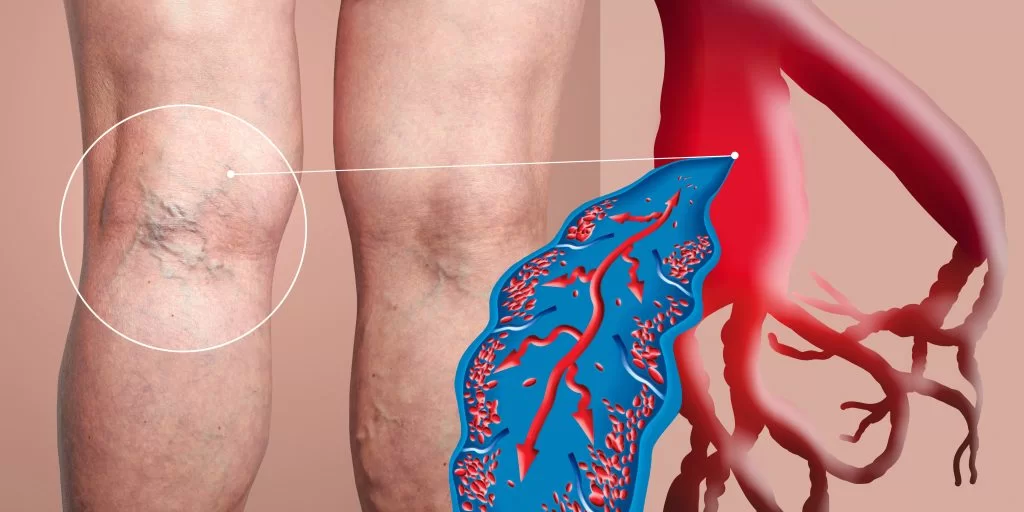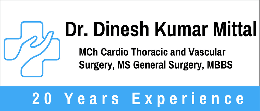Can Varicose Veins Lead to Heart Problems?

Have you ever noticed bulging, twisted veins on your legs and wondered what they are? These are called varicose veins, enlarged veins that commonly develop with age, especially in the lower legs, due to poor blood flow. Usually, people view them as a cosmetic issue or a source of occasional discomfort. Although many people may not be harmed by it, there are concerns about its long-term effects on overall health, especially on the heart.
Over 30% of adults worldwide suffer from varicose veins, and women are nearly twice as likely as men to get them. According to studies, varicose veins are one of the most common signs of chronic venous insufficiency, affecting over half of people over 50 years of age.
In this blog, we will discuss the relationship between varicose veins and cardiovascular health, are varicose veins are a sign of heart disease, and what you can do to prevent these challenges from getting worse.
Understanding Varicose Veins
Varicose veins are enlarged, twisted veins that usually appear just beneath the surface of the skin, most commonly on the legs or feet. They occur when veins struggle to send blood back to the heart. Instead of moving smoothly, blood can start to pool, making the veins stretch and become more visible. While varicose veins are often just a cosmetic issue for many people, they can actually cause uncomfortable symptoms, such as aching, swelling, heaviness, or itching in the legs.
Symptoms and Causes of Varicose Veins
What are the symptoms of Varicose Veins?
Varicose veins are visibly identified as twisted, blue, or purple veins just beneath the skin’s surface. These can frequently cause the following symptoms:
- Bulging Veins: These veins often appear swollen, twisted, and rope-like, typically on the legs, ankles, or feet.
- Heavy legs: The legs may feel unusually heavy, tired, or fatigued, especially after standing or physical activity for extended periods.
- Itching: Itching or irritation of the skin surrounding the afflicted vein is possible.
- Skin discolouration: Varicose veins can cause skin discolouration and, in extreme situations, painful venous ulcers (open sores) on the skin if they are not adequately treated.
Dr. Dinesh Kumar Mittal adds, “In many patients, symptoms like fatigue or swelling are often dismissed until they interfere with daily life. The earlier we evaluate and treat varicose veins, the better the outcome, not just for leg health, but for long-term cardiovascular stability as well.”
What Causes Varicose Veins?
Veins have tiny one-way valves that help blood flow in the right direction toward the heart. When these valves are weakened or broken, blood can backflow and pool in the vein. This added pressure makes the veins swell and twist, resulting in varicose veins.
What Increases the Risk?
Several factors that increase the chance of developing varicose veins are:
- Age: With age, the tiny valves in our veins may weaken, making it easier for blood to pool and veins to become varicose.
- Gender: Women are more likely to develop them, possibly due to hormonal changes from pregnancy, periods, or menopause.
- Pregnancy: Pregnancy puts extra pressure on the veins and increases blood volume, making varicose veins more likely to develop.
- Family History: Genetics play a strong role.
- Obesity: Obesity puts more pressure on the veins.
- Lifestyle: Sitting or standing for long periods without movement can hurt circulation.
Although varicose veins are generally not harmful, they can occasionally indicate more serious circulation issues, which raises concerns about their potential relationship to heart health.
Are Varicose Veins a Sign of Heart Disease?
This is one of the most frequently asked questions by patients who notice changes in their veins. While varicose veins are not a direct cause of heart disease, they can sometimes be a marker of poor vascular health, especially in those with chronic venous insufficiency (CVI).
CVI occurs when the vein walls or valves in the legs don’t work effectively, making it difficult for blood to return to the heart. This leads to blood pooling in the legs, swelling, and changes to the skin.
CVI is not the same as heart failure, but both conditions reflect underlying issues in the circulatory system. When combined with other cardiovascular risk factors, such as high blood pressure, obesity, or diabetes, CVI and varicose veins can indicate a more general circulatory compromise.
Dr. Dinesh Kumar Mittal states, “Chronic venous insufficiency and varicose veins might not be directly linked to heart failure, but they both often point to poor circulatory health, which should never be ignored”.
What Heart Problems Can be Caused by Varicose Veins?
Varicose veins are usually considered a cosmetic or localised issue, but in some cases, they can be linked to broader circulatory problems that indirectly affect heart health.
- Chronic venous insufficiency (CVI): It is a condition where blood pools in the legs due to weakened valves. CVI can lead to leg swelling, heaviness, and fatigue, symptoms that sometimes overlap with right-sided heart failure, making diagnosis more complex.
- Deep vein thrombosis (DVT): This is a condition that can develop in people with severe venous disease. If a clot from DVT travels to the lungs, it can result in a pulmonary embolism, a potentially life-threatening condition that puts strain on the heart and may lead to heart failure if untreated.
People with varicose veins may also have other cardiovascular risk factors like obesity, sedentary lifestyle, or high blood pressure, further increasing their chances of heart problems.
In short, while varicose veins themselves don’t harm the heart, they can be part of a bigger problem involving poor circulation and vascular strain, especially in older adults.
If symptoms persist or worsen, medical evaluation is essential to rule out severe underlying conditions.
What Are the Shared Risk Factors Between Varicose Veins and Heart Disease?
Although they affect different parts of the circulatory system, varicose veins and heart disease share several common risk factors:
| Risk Factor | Impact on Veins | Impact on Heart |
| Obesity | Increase pressure on leg veins | Elevates the risk of hypertension |
| Age | Weakens the vein valves | Stiffen arteries increase heart risk |
| Smoking | Damages the blood vessel lining | Linked to atherosclerosis and heart attacks |
| Sedentary Lifestyle Disease | Weakens circulation, worsens varicosities | Contributes to cardiovascular disease |
| Genetics | Predisposition to vein problems | May influence the risk of heart disease |
Because of these shared factors, individuals with varicose veins should not assume they are risk-free from heart problems. A holistic cardiovascular assessment is often advisable.
When to See a Doctor?
Seek medical advice if you experience:
- Persistent leg pain or swelling
- Discolouration or thickening of the skin around the veins
- Open sores or ulcers near varicose veins
- Sudden chest pain and difficulty breathing
- Rapid heartbeat or dizziness
If symptoms suggest cardiovascular involvement, a venous ultrasound or an echocardiogram is recommended to assess blood flow and check for clots.
“I had lived with varicose veins for over a decade, thinking they were just cosmetic. However, after consulting with Dr. Mittal, I learned that they were affecting my circulation. The treatment he recommended not only improved my legs but also my energy levels and sleep,” shared one of the patients of Dr. Dinesh Mittal.
How to Manage Varicose Veins?
Even though varicose veins don’t directly cause heart disease, managing them can help improve overall circulatory health and prevent varicose veins from worsening.
- Stay Active: Regular exercise, such as walking, swimming, or cycling, promotes healthy blood flow and can help prevent varicose veins from worsening.
- Maintain a Healthy Weight: Maintaining a healthy weight reduces pressure on your veins and lowers your risk for heart disease.
- Elevate Your Legs: Lifting your legs above your heart can help reduce swelling and promote blood flow back to your heart.
- Wear Compression Stockings: Compression stockings ease pain and increase blood flow in your legs. They also prevent blood from clotting.
- Eat a Heart-Healthy Diet: Focus on foods high in fibre, such as fruits, vegetables, lean meats, whole grains, and healthy fats. Limit processed foods and salt.
- Quit Smoking: When you quit smoking, your risk of cardiovascular disease is decreased, and your vein and artery health improves.
Another patient shared her experience: “I thought my leg pain was just from standing too long at work, but the swelling kept getting worse. Dr. Mittal helped me understand how poor circulation was affecting me. After minimally invasive treatment and wearing compression stockings regularly, I feel lighter and healthier overall. Even my blood pressure improved!”
Final Thoughts
While varicose veins themselves are not usually dangerous, they can indicate underlying circulatory problems that could strain your heart over time. By recognising the potential risks, you can take steps to manage varicose veins and protect your heart health. Regular exercise, maintaining a healthy weight, and seeking appropriate medical treatment are key to preventing complications. If you have varicose veins, don’t dismiss them as merely cosmetic—pay attention to the signs and take proactive steps to ensure your overall health, including your heart.
FAQs
1. Do men also get varicose veins?
Yes, although varicose veins are more common in women due to hormonal factors, men can also develop them, especially if they have risk factors like obesity, genetics, or a sedentary lifestyle.
2. Can varicose veins appear in places other than the legs?
Yes, while they are most common in the legs, they can also occur in the pelvic area, rectum (haemorrhoids), oesophagus, and other regions.
3. Can exercise help with varicose veins?
Yes, regular low-impact exercises like walking or cycling improve blood circulation, reduce vein pressure, and strengthen muscles that aid in venous return.
4. Is the treatment of varicose veins purely cosmetic?
No. While many patients seek treatment for cosmetic reasons, varicose veins can also cause pain, swelling, and ulcers. Medical intervention can improve both appearance and health outcomes.
5. Are varicose veins dangerous?
Varicose veins are usually not dangerous but can cause complications such as ulcers, bleeding, or thrombosis. In rare cases, they may indicate more serious underlying circulatory issues.
Explore more blogs: Deep Vein Thrombosis (DVT) Prevention & Treatment: Your Essential Guide
